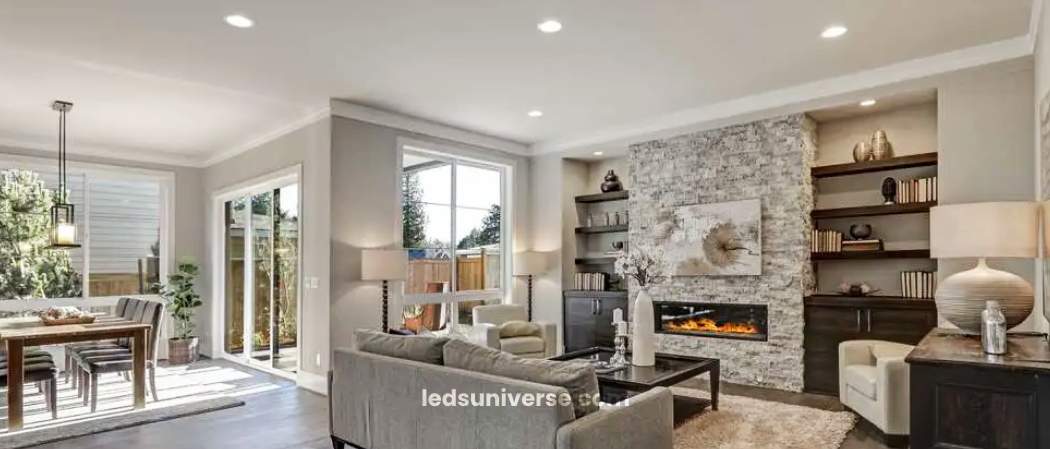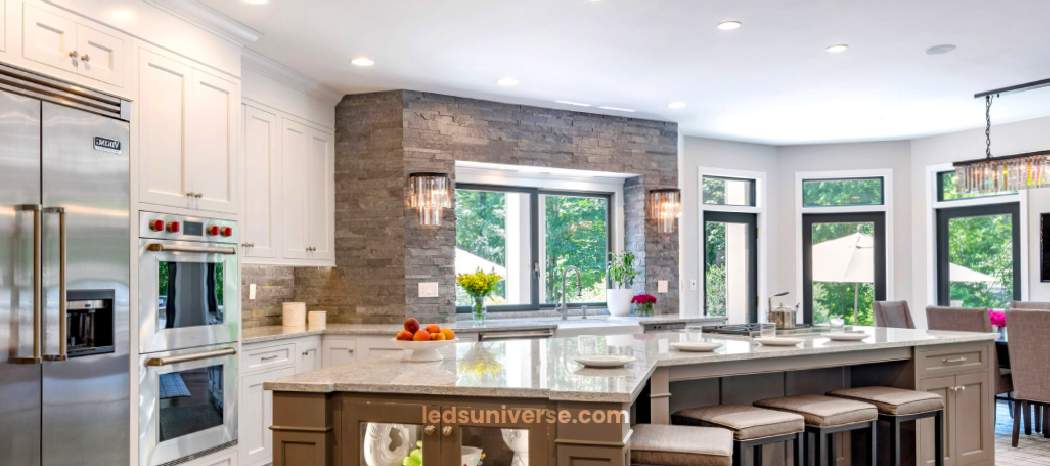Lighting sets the mood of any space, and downlights are the go-to choice for a sleek, modern touch. Discreet and versatile, they blend into ceilings while casting perfect light—whether for cozy living rooms or stylish commercial spaces. Discover how these hidden gems transform environments with effortless elegance.
Among various lighting solutions, downlights have emerged as a versatile and popular choice for both residential and commercial settings. These lights are installed into the ceiling, creating a sleek and modern look that has steadily gained momentum over the years.
Reach out for free lighting consultation
Table of Contents
ToggleDownlights, also known as recessed lights or can lights, are fixtures that are installed directly into the ceiling, allowing light to shine down in a concentrated beam. Unlike traditional hanging fixtures, downlights are subtle, blending seamlessly into the ceiling structure without drawing attention to the light source itself. This makes them an attractive option for anyone seeking clean, unobtrusive lighting that emphasizes the space rather than the fixture.
The structure of a downlight typically consists of three main components: the housing (which is recessed into the ceiling), the trim (the visible part of the light), and the bulb. The combination of these components creates a focused lighting effect, which can be tailored to different environments and uses.
There are various types of downlights available, each offering distinct characteristics depending on the design, installation needs, and the intended effect. The primary categories include fixed downlights, adjustable downlights, and LED downlights.
| Type of Downlight | Characteristics | Ideal Use Cases |
|---|---|---|
| Fixed Downlights | Provide steady, downward light; non-adjustable. Ideal for general, even illumination. | Living rooms, hallways, kitchens |
| Adjustable Downlights | Also known as directional or gimbal downlights. Can be tilted/rotated for focused lighting. | Highlighting specific areas or objects; galleries, retail |
| LED Downlights | Energy-efficient, long-lasting lights. Available in both fixed and adjustable designs. Low power consumption. | Suitable for various applications, reduces energy costs |
Fixed downlights provide a steady, downward light that is ideal for general illumination. These lights are commonly used in living rooms, hallways, and kitchens where even lighting is desired. Due to their non-adjustable nature, they are best suited for spaces where the lighting focus does not need to be changed frequently.

Adjustable downlights, also known as directional or gimbal downlights, offer flexibility in directing the light. The light fixture can be tilted or rotated, allowing for more control over where the light falls. This type is ideal for highlighting specific areas or objects, such as artwork, architectural features, or reading nooks. Adjustable downlights are often used in galleries, museums, and retail spaces to create dynamic lighting effects.
With the advancement of lighting technology, LED downlights have become a highly popular option. These energy-efficient lights not only last longer than traditional incandescent or halogen bulbs but also consume significantly less energy. LED downlights are available in both fixed and adjustable designs, making them suitable for a wide range of applications. Their long lifespan and reduced power consumption have made them a preferred choice for homeowners and businesses looking to reduce energy costs while maintaining quality lighting.
Downlights offer a multitude of benefits, making them a sought-after lighting solution in many settings. Their design and functionality provide advantages over other types of lighting, enhancing both aesthetics and practicality in various environments.
One of the key benefits of downlights is their versatility. Whether you’re designing a minimalist modern home or a more traditional interior, downlights can be seamlessly incorporated into virtually any style. The fixtures are discreet, allowing them to blend into the ceiling while providing bright, effective illumination. This makes them ideal for spaces where you don’t want the light fixtures to detract from the overall design, such as in rooms with low ceilings or open-plan layouts.
Downlights also come in a variety of shapes, sizes, and finishes, making it easy to find a fixture that complements the specific aesthetic of the room. From sleek metallic trims to more muted white finishes, the trim style can be customized to suit the décor.
The ability of downlights to provide both ambient and task lighting makes them a versatile choice for multiple purposes. Ambient lighting refers to the general illumination of a space, creating an overall brightness that enhances the visibility and atmosphere of the room. When installed in strategic locations, downlights can provide even illumination that helps reduce shadows and dark spots.
For task lighting, downlights can be positioned over workspaces or reading areas to provide focused light that aids in activities requiring more precision, such as cooking, reading, or working on crafts. Adjustable downlights, in particular, are well-suited for this purpose, as they allow the user to control where the light is directed.
LED downlights are renowned for their energy-saving properties, consuming a fraction of the energy used by traditional bulbs while producing the same level of brightness. This energy efficiency not only reduces electricity bills but also contributes to environmental sustainability. With many consumers becoming increasingly conscious of their carbon footprint, LED downlights provide a responsible solution without compromising on light quality.
Moreover, the long lifespan of LED bulbs means that they require less frequent replacement, reducing maintenance costs and the inconvenience of having to change lightbulbs frequently. This makes them an appealing choice for areas that are difficult to access, such as high ceilings or recessed spaces.

Installing downlights requires careful planning to ensure optimal light distribution and safety. While the installation process can vary depending on the type of downlight and the structure of the ceiling, there are general considerations that apply to most downlight installations.
The placement of downlights is crucial for achieving the desired lighting effect. If placed too far apart, they may create uneven lighting with dark patches, while placing them too close together may result in over-illumination, leading to a harsh and clinical environment. The spacing between downlights should typically be around 1.5 to 2 meters, though this can vary depending on the size of the room, the height of the ceiling, and the purpose of the lighting.
In larger rooms, creating a grid layout can ensure even distribution of light, while in smaller spaces, fewer downlights may be needed to provide adequate illumination. It’s also vital to consider the purpose of the space. For example, in kitchens, placing downlights above countertops can provide task lighting, while in living rooms, downlights might be positioned to highlight seating areas or artwork.
Incorporating dimmable downlights can add an extra layer of flexibility to the lighting design. Dimmers allow you to adjust the brightness of the lights to suit different activities and moods. For instance, you might want bright lighting while cooking or working but prefer softer, more subdued lighting when relaxing or watching a movie.
LED downlights are compatible with dimmer switches, though it’s essential to ensure that the dimmer is designed for use with LED lights to avoid flickering or reduced lifespan. Installing dimmable downlights provides greater control over the lighting in the room, allowing it to transition from functional to atmospheric as needed.
Proper installation of downlights is essential for safety. Incorrect installation can pose fire risks, especially if the fixtures are in contact with insulation materials in the ceiling. To mitigate these risks, many modern downlights come with fire-rated enclosures, which help to prevent the spread of fire through the ceiling cavity. Additionally, it’s crucial to ensure that the lights are adequately ventilated to avoid overheating.
Hiring a qualified electrician is recommended for the installation of downlights, particularly in complex or large-scale projects. An experienced professional can ensure that the lights are installed correctly and that they comply with local safety regulations.
Downlights can be used in a variety of environments, both residential and commercial. Their ability to provide both general and focused lighting makes them an adaptable solution for a wide range of settings, from cozy living rooms to expansive office spaces.
In homes, downlights are often used to create a clean, modern look while providing practical lighting. They are commonly installed in living rooms, kitchens, hallways, and bathrooms. The discreet nature of downlights makes them particularly suitable for contemporary and minimalist designs, where the emphasis is on clean lines and uncluttered spaces.
In living rooms, downlights can be positioned around the perimeter of the room to provide ambient lighting, while adjustable downlights can be directed toward artwork or specific seating areas. In kitchens, downlights placed over countertops and islands can provide task lighting, enhancing visibility during food preparation and cooking. Bathrooms can also benefit from downlights, especially in shower areas, where they can provide focused lighting without the need for bulky fixtures.
In commercial settings, downlights are frequently used in offices, retail stores, and hospitality environments. Their ability to provide bright, uniform lighting makes them ideal for areas that require high visibility, such as workspaces and customer-facing areas.
In office environments, downlights can be installed in a grid pattern to ensure even lighting throughout the workspace. This reduces eye strain and creates a comfortable working environment. Dimmable downlights are also becoming popular in offices, as they allow for adjustments based on natural light levels and the time of day.
In retail spaces, adjustable downlights can be used to highlight merchandise, drawing attention to specific products and creating a more dynamic shopping experience. Restaurants and hotels can use downlights to create a welcoming atmosphere, with dimmable options providing the ability to adjust the lighting based on the time of day or the mood desired.
Selecting the right downlight for a space involves considering several factors, including the type of lighting desired, the style of the room, and the overall functionality. With a wide range of options available, it can be challenging to determine which downlight best suits a specific environment.
When choosing downlights, it’s crucial to consider the brightness of the light, measured in lumens, and the color temperature, which is measured in Kelvins. The lumen output determines how bright the light will be, with higher lumens providing more intense light. For general ambient lighting, a lower lumen output might be sufficient, while task lighting typically requires brighter light.
The color temperature of the light can also have a significant impact on the atmosphere of a room. Warmer color temperatures (around 2700K-3000K) provide a soft, cozy light that is ideal for living rooms and bedrooms. Cooler color temperatures (4000K-5000K) offer a more neutral or daylight-like effect, making them suitable for kitchens, bathrooms, and workspaces where brighter, more focused light is required.
The beam angle of a downlight refers to the spread of the light from the fixture. A narrower beam angle (15-30 degrees) creates a more focused light, which is ideal for spotlighting or task lighting. Wider beam angles (60-120 degrees) provide more diffuse lighting, suitable for general illumination in larger areas.
Carefully considering the beam angle is essential when planning the lighting layout. Narrower beams can create dramatic effects by highlighting specific areas, while wider beams help to create a more even distribution of light throughout the space.
Downlights offer a sleek and versatile lighting solution suitable for various environments. Their unobtrusive design, combined with the ability to provide both ambient and task lighting, makes them a popular choice in modern lighting design. Whether in a residential or commercial setting, downlights contribute to the overall functionality and aesthetic of a space, offering flexibility, energy efficiency, and tailored lighting effects. By carefully planning their placement, adjusting brightness levels, and selecting the appropriate color temperature and beam angle, downlights can enhance the atmosphere and usability of any room.